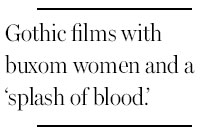Reviving horror studio for a new audience
Updated: 2012-02-05 08:03
By Jason Zinoman(The New York Times)
|
|||||||
Few names in horror command more respect than Hammer.
The director John Carpenter has said that seeing "The Curse of Frankenstein," the first gothic hit by Hammer Film Productions, as a kid transformed him. And Martin Scorsese has described the obscure "Frankenstein Created Woman" as "close to something sublime."
Yet the tiny British company struggled through the 1970s, finally ceasing production right as the horror genre boomed.
Reviving Hammer, built on sequels and remakes, has proved far more difficult than reanimating Frankenstein's monster.
A group looked into buying Hammer in the 1980s before discovering that it didn't own many of its best-known properties. A consortium led by the art dealer Charles Saatchi did buy Hammer in 2000, without making any new films. In 2007 Simon Oakes, a cable television executive, spearheaded the acquisition of the company's film library and raised what was reported as $50 million to make new movies.
His challenge is capitalizing on the affection for Hammer while updating the company. In its heyday, roughly a decade starting in the mid-1950s, the films broke ground with their lush Technicolor, sexual frankness and unlikely mix of class and teasing exploitation. But Hammer films are relatively unknown to young audiences reared on films like "Paranormal Activity."

The early efforts by the rebooted Hammer, including the acclaimed remake "Let Me In" and "The Resident," have not found huge box office success. But Mr. Oakes said that those were only "building blocks" setting up his ambitious next move, a $13 million adaptation of "The Woman in Black," opening worldwide this winter.
Like the classic Hammer movies, this ghost story, shot in Britain, is a period piece with a high-toned pedigree. In keeping with Hammer tradition, it has a star. In his first post-Harry Potter film role, Daniel Radcliffe plays a guilt-ridden father and lawyer who starts seeing ghosts while going through the estate of a deceased woman. "For Hammer to succeed, it has to honor its legacy," Mr. Oakes said.
Hammer was founded in 1934 by a group led by a music hall comic named William Hinds (his stage name was Will Hammer). Its most sustained and successful movies were gothic costume dramas that revisited the classic Universal Pictures monsters.
This cycle kicked off in 1957 with the taut "Curse of Frankenstein," a significant departure from the Boris Karloff classic. Hammer augmented the doctor character and made the monster appear more human. In a decade full of flying saucers and atomic age-inspired beasts, Hammer scares were often found in close-ups of the human face.
A dry English wit also sneaks into these creepy productions. Peter Cushing, one of Hammer's two biggest stars, played Dr. Frankenstein opposite the other, Christopher Lee, as the monster. After assisting the monster in a killing, Cushing opens the next scene at breakfast, with a civilized, "Pass the marmalade."
The success of "The Curse of Frankenstein" led in 1958 to "Horror of Dracula," in which Mr. Lee's vampire captivated a young Mr. Scorsese, who recently cast him in "Hugo." Hammer movies, replete with heaving bosoms, were often more explicit about sex than violence. "People wanted the beautiful women with the splash of blood," said Shane Briant, who appeared in four Hammer movies.
In the early 1970s, American horror films like the brutal "Texas Chainsaw Massacre" and "The Exorcist" made Hammer seem stuffy.
Hammer recast vampires in a modern context ("Dracula A.D. 1972") and offered nude lesbian vampires ("The Vampire Lovers"). But such attempts often seemed random and desperate.
The push for more explicit and outrageous material in horror has hardly abated, but instead of trying to compete, the new Hammer is defiantly upscale. "Let Me In" was one of the best-reviewed horror remakes ever. And the director of "The Woman in Black," James Watkins, says scares are not the whole point. The film is "about something," he said. "It's about loss."
And there is not a heaving bosom in attendance.
The New York Times
(China Daily 02/05/2012 page12)